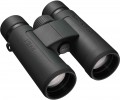Twilight factor
A complex indicator that describes the quality of binoculars / monoculars at dusk — when the illumination is weaker than during the day, but not yet as dim as in the deep evening or at night. It is primarily about the ability to see small details through the device. The need to use this parameter is due to the fact that twilight is a special condition. In daylight, the visibility of small details through binoculars is determined primarily by the magnification of the optics, and in night light, by the diameter of the lens (see below); at dusk, both of these indicators affect the quality. This feature takes into account the twilight factor. Its specific value is calculated as the square root of the product of the multiplicity and the diameter of the lens. For example, for 8x40 binoculars, the twilight factor will be the root of 8x40=320, that is, approximately 17.8. In models with power adjustment (see above), the minimum twilight factor is usually indicated at the lowest magnification, but data is often given for the maximum. The lowest value of this parameter for normal visibility at dusk is considered to be 17. At the same time, it is worth noting that the twilight factor does not take into account the actual light transmission of the system — and it strongly depends on the quality of lenses and prisms, the use of antireflection coatings, etc. Therefore, the actual image quality at dusk for two models with the same twilight factor may differ markedly.
Relative brightness
One of the parameters describing the quality of visibility through an optical device in low light conditions. Relative brightness is denoted as the diameter of the exit pupil (see below) squared; the higher this number, the more light the binoculars/monoculars let through. At the same time, this indicator does not take into account the quality of lenses, prisms and coatings used in the design. Therefore, comparing the two models in terms of relative brightness is only possible approximately, since even if the values are equal, the actual image quality may differ markedly.
Diopter adjustment
The presence in binoculars / monoculars of the function of diopter correction. This feature will be very useful if you wear glasses due to nearsightedness or farsightedness. By setting the required number of "plus" or "minus" diopters on the adjustment scale, you can look into the eyepiece with the naked eye and see a clear picture — the optics of the device will provide the necessary correction. It is much more convenient than watching through glasses. However one should not forget that the correction range (see below) is usually small, and in case of serious visual impairments, the capabilities of the binoculars may not be enough; but such situations are still quite rare. In binoculars (see "Type"), this adjustment is usually carried out for each eyepiece separately, because The diopters required for each eye may also be different. Features of the correction control depend on the type of focus (see below). With separate focus, each eyepiece is adjusted with its own regulator, with the central one of the halves (usually the left) is regulated using a common focus handwheel, and the second with a separate knob on the eyepiece (although here there are separate regulators on both eyepieces).
Interpupillary distance
Interpupillary distance adjustment range provided in binoculars with the corresponding function.
Recall that, ideally, the interpupillary distance of the device should correspond to the distance between the centers of the pupils of the user himself. With this calculation, it is worth choosing binoculars according to this parameter; and if the device will be used by several people, it is worth making sure that they all “fit” into the adjustment range of the selected model. However, not every person knows exactly their interpupillary distance, especially since it changes with age; and the circle of users can be indefinite — for example, if we are talking about "rolling" binoculars in the hunting industry. In such cases, it is worth proceeding from the following.
In adults of more or less standard physique, the interpupillary distance is in the range from 60 to 66 mm. Modern binoculars cover this range with a margin — even the most modest models support values from 60 to 70 mm, and in most cases the lower limit of the range lies in the region of 54 – 57 mm, and the upper one — 72 – 75 mm. This is quite enough for most adults, including those with a non-standard physique — miniature, or vice versa, large. So a wider range may come in handy only in special cases. For example, if a child will use binoculars, it is desirable that the lower adjustment limit be lower than the standard 50 – 55 mm (in some models, this limit is at the level of 38 mm, or even 34 mm).
Shockproof
The presence in the design of binoculars/monoculars of a
reinforced body that protects sensitive optics from bumps and falls. The degree of such protection may vary between models, but even the simplest of them can usually withstand an accidental fall from your hands onto a hard surface without stones or other dangerous objects.
Case
The presence of a
cover in the scope of supply of binoculars / monoculars. The case is useful for transporting the device — it protects it from shock and dirt, to which complex optics are very sensitive.

